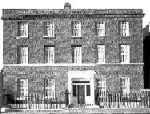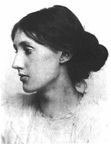Virginia Woolf and Hogarth House
Local history note on Virginia Woolf.
It is difficult to imagine a more favourable family background for a future writer than that of Virginia Woolf. She was born in London, the second daughter (by his second marriage) of Leslie Stephen, the eminent critic, biographer, philosopher and scholar. Her father took charge of her education himself and from an early age she was allowed access to his magnificent library. During her childhood which was spent at her family’s house at Hyde Park Gate, London and at their country house in St. Ives, Cornwall, she displayed those characteristics which were to develop and intensify themselves in later life: a brilliant creative intelligence, allied to a delicate nervous constitution.
After her father’s death in 1904, she moved with her sister Vanessa and her brother Adrian to 26, Gordon Square, Bloomsbury, where her first serious writing began. The earliest work consisted of literary criticism: she contributed articles to various journals and remained a reviewer for the Times Literary Supplement until her death.
The house in Gordon Square became the regular meeting place for a group of brilliant young men whom Virginia’s eldest brother, Thoby, had known at Cambridge. They included Roger Fry, J.M. Keynes, Lytton Strachey, E.M. Forster, Leonard Woolf and Clive Bell. To those outside its circle, the group became known as the "Bloomsbury Group".
In 1912, Virginia married a member of the group: Leonard Woolf, a journalist, publicist and writer on political topics. The couple lived partly in London and partly in Sussex.
In October 1914, Leonard and Virginia Woolf moved to Richmond, where they occupied rooms in a house on the east side of The Green: number 17. Leonard describes some amusing incidents which he experienced here in the volume of his autobiography called Beginning again. (1964).
 Hogarth House. Photograph.
Hogarth House. Photograph.
Early in March 1915 the couple moved to Hogarth House in Paradise Road. This was part of the present Suffield House, at that time divided into two separate residences, situated next to the premises of the North Surrey Squash Rackets Club.
The move to Hogarth House came at an unhappy and unsettled period in their life, for Virginia was suffering from a severe attack of the mental illness which was to recur at various times during her life. In 1913 she had completed her first novel The Voyage Out (published in 1915). As was the case with each book that she wrote, the work had left her in a state of extreme physical, mental and nervous exhaustion and in September 1913 she attempted to take her own life. By the summer of 1914 she appeared to have fully recovered. In February 1915, however, there was another, more violent recurrence of the illness which this time lasted until about 1917.
Leonard was anxious to find some hobby or occupation in which he and his wife could engage and which would serve as a relief from her writing, with all its attendant mental stress. They were both interested, as amateurs, in the art of printing and in March 1917 they purchased a small handpress, some old typeface and the necessary accompanying implements and materials. The first book was issued from this modest equipment in July 1917. It was a 32 page pamphlet entitled Two stories containing Virginia’s story The Mark on the wall and one by her husband called Three Jews. The title page bore the imprint "Hogarth Press, Richmond 1917". Thus began the life of a publishing house which was to become world famous.
In the years immediately following, the business of the press expanded rapidly, additional equipment was installed at Hogarth House and some of the work of printing was handled by outside firms. However, sixteen of the thirty-two books which were published during the years that the press was in Richmond (1917 to 1924) were printed by the Woolfs’ own hand. These sixteen included two works of Virginia’s: the story mentioned above and Kew Gardens. In the latter, the author conveys not only the visual impression of the gardens themselves but also the mood of the typical and symbolic characters that haunt them.
In her diary on July 20th 1919, she describes, with typically acute observation, her impressions of the "peace" celebrations held in Richmond that year:
"…After sitting through the procession and the peace bells unmoved, I began after dinner to feel that if something was going on, perhaps one had better be in it…The doors of the public house at the corner were open and the room crowded; couples waltzing; songs being shouted, waveringly, as if one must be drunk to sing. A troop of little boys with lanterns were parading the Green, beating sticks. Not many shops went to the expense of electric light. A woman of the upper classes was supported dead drunk between two men partially drunk.
"We followed a moderate stream flowing up the Hill. Illuminations were almost extinct half way up, but we kept on till we reached the Terrace. And then we did see something – not much indeed, for the damp had deadened the chemicals. Red and green and yellow and blue balls rose slowly in the air burst, flowered into an oval of light, which dropped into minuter grains and expired. There were hazes of light at different points. Rising over the Thames, among trees, these rockets were beautiful; the lights on the faces of the crowd was strange; yet of course there was grey mist muffling everything and taking the blaze off the fire…"
Besides The Mark on the wall and Kew Gardens, two of Virginia’s other works were first published under the Richmond imprint of the Hogarth Press: the collection of short sketches called Monday or Tuesday (1921) and the novel Jacob’s room (1922). The appearance of the former marked the real turning point of Virginia’s career, for in these sketches she was experimenting with a new technique of writing which enabled her, in the words of David Daiches :-
"to embody in fiction her conception of the flux of experience, a style that was flexible, impressionistic, meditative."
This technique was to be further developed in Jacob’s room and the novels that followed.
The Woolfs moved from Hogarth House to 52, Tavistock Square, London in March 1924.
Besides writing novels and short stories, Virginia also assisted S.S. Koteliansky in translating a number of Russian works into English. Her critical writings are, of course, another important part of her work, notably the two collection called The Common reader (published in 1925 and 1932) which contain some of her best prose.
Her last novel, published in the year of her death was Between the Acts. Early in 1941, the symptoms of mental illness reasserted themselves and in April of that year she drowned herself in the river near the house which she and Leonard owned in Rodmell, Sussex.
 Virginia Woolf. Photograph.
Virginia Woolf. Photograph.
Up to: Local history notes
Updated: 22 October 2020
 Stay up to date! Make sure you subscribe to our email updates.
Stay up to date! Make sure you subscribe to our email updates.
